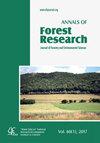部分自动化对移动塔式堆场生产效率和成本的影响
IF 1.7
3区 农林科学
Q2 FORESTRY
引用次数: 8
摘要
技术集成在支持更高水平的自动化和效率的林业设备中是司空见惯的。要使技术的采用取得成功,它必须证明在生产力、成本效益或人的因素和人体工程学方面有所改善。电缆堆场可以实现自动化,沿着固定的走廊重复机器运动,正如天际线所建立的那样。本研究旨在调查瓦伦蒂尼V850堆场两种可能设置(手动和自动)之间的生产力差异,该堆场配备了自动路径编程,配有Bergwald 3-t车厢和无线电控制的扼流环。这项研究在意大利北部阿尔卑斯东部地区进行,为期8天,在两条不同的走廊上进行,结果是280个测量周期分为手动和自动。两种系统选择的结果在绝对数字方面非常接近,但发现了显著差异。例如,自动化系统的进站时间较长,但出站时间较短。产能范围为8.2至13.3 m3 PMH-1,成本约为20至30€m-3。自动化系统确实实现了更高的生产率,但差异随着提取距离的增加而下降。考虑到自动化系统的成本略高,在200米以内的提取距离上,自动化系统更具成本效益,而在更远的距离上,人工系统更具成本效益。本文章由计算机程序翻译,如有差异,请以英文原文为准。
The effect of partial automation on the productivity and cost of a mobile tower yarder
t Integration of technology is commonplace in forestry equipment supporting higher levels of automation and efficiency. For technology adoption to be successful it must demonstrate improvement in productivity, cost–effectiveness or in human factors and ergonomics. Cable yarding lends itself to automation with repetitive machine movement along a fixed corridor, as established by the skyline. This study aimed at investigating the difference in productivity between the two possible settings (manual and automated) of a Valentini V850 yarder equipped with automatic path programming, with a Bergwald 3-t carriage and radio controlled chokers. The study took place in the northern Italian Alpine eastern region over a period of 8 days on two separate corridors, resulting in 280 measured cycles split between manual and automated. Results in terms of absolute numbers were very close for the two system options, but significant differences were found. For example, inhaul time was longer, but outhaul time shorter for the automated system. Productivity ranged from 8.2 to 13.3 m3 PMH-1, and cost from approximately 20 to 30 € m-3. The automated system did achieve a significantly higher productivity, but differences declined with extraction distance. When that was combined with the slightly higher cost for the automated system, the automated system was more cost-effective on extraction distances less than 200 m, and the manual system on longer distances.
求助全文
通过发布文献求助,成功后即可免费获取论文全文。
去求助
来源期刊

Annals of Forest Research
FORESTRY-
CiteScore
2.20
自引率
11.10%
发文量
11
审稿时长
12 weeks
期刊介绍:
Annals of Forest Research is a semestrial open access journal, which publishes research articles, research notes and critical review papers, exclusively in English, on topics dealing with forestry and environmental sciences. The journal promotes high scientific level articles, by following international editorial conventions and by applying a peer-review selection process.
 求助内容:
求助内容: 应助结果提醒方式:
应助结果提醒方式:


